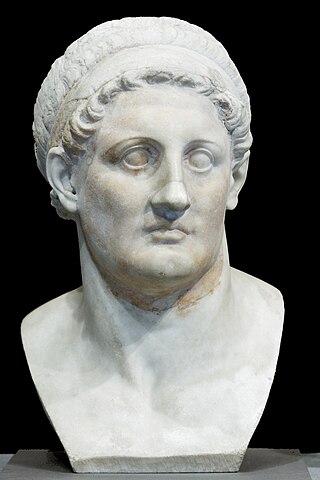
The Ptolemaic dynasty, also House of Ptolemy, or Lagid dynasty, was a Macedonian Greek royal dynasty which ruled the Ptolemaic Kingdom in Ancient Egypt during the Hellenistic period. Their rule lasted for 275 years, from 305 to 30 BC. The Ptolemaic was the last dynasty of ancient Egypt.

The Seleucid dynasty or the Seleucidae was a Macedonian Greek royal family, founded by Seleucus I Nicator, which ruled the Seleucid Empire centered in the Near East and regions of the Asian part of the earlier Achaemenid Persian Empire during the Hellenistic period.
This article concerns the period 359 BC – 350 BC.

This article concerns the period 329 BC – 320 BC.

Ptolemy I Soter was a Macedonian Greek general, historian and successor of Alexander the Great who went on to found the Ptolemaic Kingdom centered on Egypt and led by the Ptolemaic dynasty from 305 BC – 30 BC. Ptolemy was basileus and pharaoh of Ptolemaic Egypt from 305/304 BC to his death, during which time Egypt became a thriving bastion of Hellenistic civilization and Alexandria a great seat of Greek culture.

Antiochus I Soter was a Greek king of the Seleucid Empire. Antiochus succeeded his father Seleucus I Nicator in 281 BC and reigned during a period of instability which he mostly overcame until his death on 2 June 261 BC. He is the last known ruler to be attributed the ancient Mesopotamian title King of the Universe.

Seleucus I Nicator was a Macedonian Greek general, officer and successor of Alexander the Great who went on to found the eponymous Seleucid Empire, led by the Seleucid dynasty. In the power struggles that followed Alexander's death, Seleucus rose from being a secondary player to becoming the total ruler of Asia Minor, Syria, Mesopotamia, and the Iranian plateau, assuming the title of basileus (emperor). The Seleucid Empire was one of the major powers of the Hellenistic world, until it was overcome by the Roman Republic and Parthian Empire in the late second and early first centuries BC.

Lysimachus was a Thessalian officer and successor of Alexander the Great, who in 306 BC, became King of Thrace, Asia Minor and Macedon.

The Diadochi were the rival generals, families, and friends of Alexander the Great who fought for control over his empire after his death in 323 BC. The Wars of the Diadochi mark the beginning of the Hellenistic period from the Mediterranean Sea to the Indus River Valley.

Magas of Cyrene was a Greek King of Cyrenaica. Through his mother’s second marriage to Ptolemy I he became a member of the Ptolemaic dynasty. He managed to wrest independence for Cyrenaica from the Greek Ptolemaic dynasty of Ancient Egypt, and became King of Cyrenaica from 276 BC to 250 BC.
Spitamenes was a Sogdian warlord and the leader of the uprising in Sogdiana and Bactria against Alexander the Great, King of Macedon, in 329 BC. He has been credited by modern historians as one of the most tenacious adversaries of Alexander.

Artabazos II was a Persian general and satrap of Hellespontine Phrygia. He was the son of the Persian satrap of Hellespontine Phrygia Pharnabazus II, and younger kinsman of Ariobarzanes of Phrygia who revolted against Artaxerxes II around 356 BC. His first wife was an unnamed Greek woman from Rhodes, sister of the two mercenaries Mentor of Rhodes and Memnon of Rhodes. Towards the end of his life, he became satrap of Bactria for Alexander the Great.

The Susa weddings was a mass wedding arranged by Alexander the Great in 324 BC in the Persian city of Susa.
Pharnabazus III was a Persian satrap who fought against Alexander the Great. His father was Artabazus II, and his mother a Greek from Rhodes.
Antigone was a Macedonian Greek noblewoman. Through her mother's second marriage she was a member of the Ptolemaic dynasty and through her marriage to Pyrrhus she was queen of Epirus.
Apama II, sometimes known as Apame II was a Syrian Greek princess of the Seleucid Empire, queen of Cyrenaica by marriage to King Magas of Cyrene.
Theoxena was a Greek Macedonian noblewoman. Through her mother's second marriage, she was a member of the Ptolemaic dynasty and through marriage was a queen of Sicily, Magna Graecia.
Lysimachus also known as Lysimachus Junior was a Greek Prince from Asia Minor who was of Macedonian and Thessalian descent.
Philip was a Greek prince from Asia Minor who was of Macedonian and Thessalian descent.
Ptolemy Epigonos was a Greek Prince from Asia Minor who was of Macedonian and Thessalian descent.











